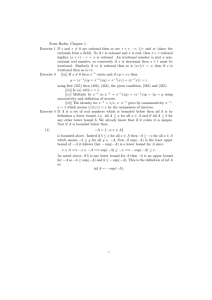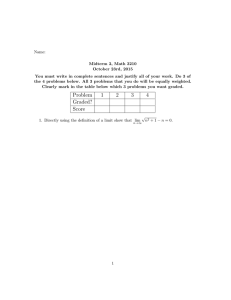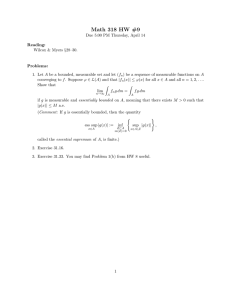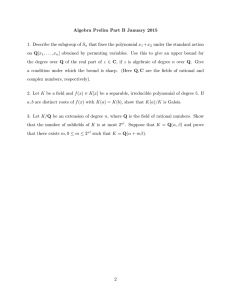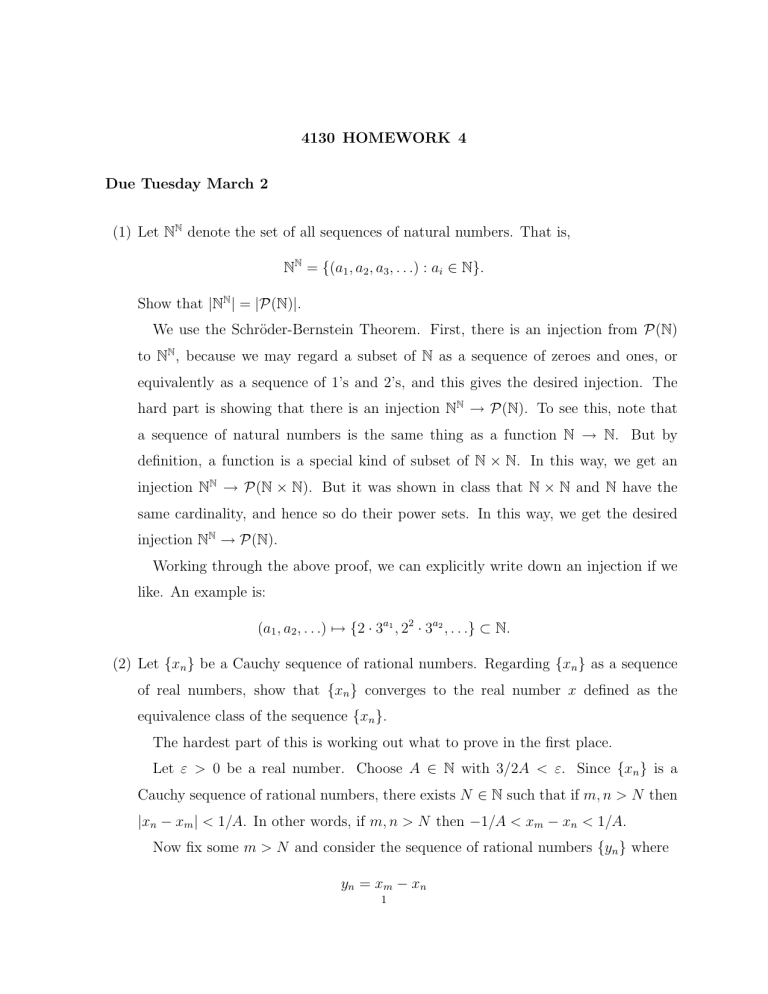
4130 HOMEWORK 4
Due Tuesday March 2
(1) Let NN denote the set of all sequences of natural numbers. That is,
NN = {(a1 , a2 , a3 , . . .) : ai ∈ N}.
Show that |NN | = |P(N)|.
We use the Schröder-Bernstein Theorem. First, there is an injection from P(N)
to NN , because we may regard a subset of N as a sequence of zeroes and ones, or
equivalently as a sequence of 1’s and 2’s, and this gives the desired injection. The
hard part is showing that there is an injection NN → P(N). To see this, note that
a sequence of natural numbers is the same thing as a function N → N. But by
definition, a function is a special kind of subset of N × N. In this way, we get an
injection NN → P(N × N). But it was shown in class that N × N and N have the
same cardinality, and hence so do their power sets. In this way, we get the desired
injection NN → P(N).
Working through the above proof, we can explicitly write down an injection if we
like. An example is:
(a1 , a2 , . . .) 7→ {2 · 3a1 , 22 · 3a2 , . . .} ⊂ N.
(2) Let {xn } be a Cauchy sequence of rational numbers. Regarding {xn } as a sequence
of real numbers, show that {xn } converges to the real number x defined as the
equivalence class of the sequence {xn }.
The hardest part of this is working out what to prove in the first place.
Let ε > 0 be a real number. Choose A ∈ N with 3/2A < ε. Since {xn } is a
Cauchy sequence of rational numbers, there exists N ∈ N such that if m, n > N then
|xn − xm | < 1/A. In other words, if m, n > N then −1/A < xm − xn < 1/A.
Now fix some m > N and consider the sequence of rational numbers {yn } where
y n = xm − xn
1
for n ≥ 1. We have chosen N so that if n > N then −1/A < yn < 1/A. This implies
that for n > N , we have
yn + 3/2A > 1/2A
and
3/2A − yn > 1/2A.
The first inequality is the statement that the real number defined as the equivalence
class of the Cauchy sequence {yn + 3/2A} is positive. (Ex: why is this sequence
Cauchy?) If we let y = [{yn }], then we have an inequality in the real numbers
y + 3/2A > 0.
Similarly, the other inequality gives
3/2A − y > 0.
Putting these together, we have, for n > N ,
−3/2A < y < 3/2A.
But y = [{xm − xn }n≥1 ] = [{xm , xm , . . .}] − [{x1 , x2 , . . .}] which is the real number
xm − x, by definition of how the rationals are embedded in the reals. Thus, we have
−3/2A < xm − x < 3/2A
and hence
|xm − x| < 3/2A < ε.
This holds for any given m > N . So we have shown that for all ε > 0 we can find
N ∈ N such that if m > N then |xm − x| < ε, as required.
(3) Section 2.2.4 # 4.
Let x ∈ R be the equivalence class of the Cauchy sequence {xn } where xi ∈ Q.
We construct a sequence qn of rational numbers which is increasing and converges
to x. To start with, take q1 ∈ Q with x > q1 > x − 1. Now suppose we have
constructed q1 , . . . , qn−1 with qn−1 < x. Let qn be a rational number with x > qn >
max{qn−1 , x − 1/n}. Then the sequence {qn } is increasing and qn < x for all n. Also,
2
qn > x − 1/n, so |x − qn | = x − qn < 1/n, and thus {qn } → x. In particular, {qn } is
Cauchy.
We now have an increasing Cauchy sequence of rational numbers {qn }, and it
remains to show that this sequence is equivalent to {xn }. For this, let ε > 0. Choose
N1 ∈ N such that if n > N1 then |x − qn | < ε/2. By the previous problem, we can
choose N2 ∈ N such that if n > N2 then |x − xn | < ε/2. Now if n > max{N1 , N2 }
then |xn − qn | ≤ |xn − x| + |x − qn | < ε, which shows that the sequences {xn } and
{qn } are equivalent sequences of rationals.
(4) Show that every subset S of R which is bounded below has a greatest lower bound.
(Hint: see p. 75 of the textbook.)
Let S be a subset of R which is bounded below. Let
−S = {−x : x ∈ S}.
Then −S is bounded above, so it has a least upper bound s := sup(−S). We claim
that −s is the greatest lower bound of S. First, −s is a lower bound because if x ∈ S
then −x ≤ −s and so x ≥ s. Also, if b is any other lower bound for −S, then −b
is an upper bound for S, and so −b ≥ s, whence b ≤ −s and so −s is the greatest
lower bound, as required.
(5) Find, if they exist, the supremum (least upper bound) and infimum (greatest lower
bound) of the following subsets of R.
(a) {1, 2, 3}.
Sup = 3, inf = 1.
(b) (0, 1) ∪ {2} ∪ [3, 4) = {x ∈ R : 0 < x < 1 or x = 2 or 3 ≤ x < 4}.
Sup = 4, inf = 0.
(c) {1 −
1
n
: n ∈ N}.
The set is {0, 1/2, 2/3, . . .}. The supremum is 1 and the infimum is the smallest
element, which is 0.
(d) Q.
This set is not bounded above or below, and so it does not have a finite sup or
inf.
(6) Prove Theorem 2.3.2 in the textbook.
3
Let {xn } and {yn } be sequences of real numbers.
(a) Suppose {xk } → x and {yk } → y. We must show that {xk + yk } → x + y. Let
ε > 0. Then there exists N1 ∈ N such that if k > N1 then |xk − x| < ε/2. There also
exists N2 such that if k > N2 then |yk − y| < ε/2. Now suppose k > max{N1 , N2 }.
Then
|(xk + yk ) − (x + y)| ≤ |xk − x| + |yk − y| < ε.
Next, we need to show that {xk yk } → xy. To do this, we first show that a
convergent sequence of real numbers is bounded. We have
|xk | ≤ |xk − x| + |x|.
Taking ε = 1, we know that there exists N such that if k > N then |xk − x| < 1.
Therefore, if k > N then |xk | < 1 + x. It follows that for all k, |xk | ≤ B where
B = max{|x1 |, |x2 |, . . . , |xN |, 1 + |x|}.
Thus, every convergent sequence of real numbers is bounded.
Now we show that {xk yk } → xy. Let ε > 0 and choose B such that |xk | ≤ B for
all k and |y| ≤ B. Choose N1 such that if k > N1 then |xk − x| < ε/2B. Choose N2
such that if n > N2 then |yk − y| < ε/2B. Then if N > max{N1 , N2 } then
|xk yk − xy| = |xk (yk − y) + y(xk − x)| ≤ |xk ||yk − y| + |y||xk − x| < ε.
Next, suppose y 6= 0. Then for all ε > 0 there exists N ∈ N such that if n > N
then |yn − y| < ε. So yn ∈ (y − ε, y + ε). If y > 0 then y − ε > 0 for some ε > 0. If
y < 0 then y + ε < 0 for some ε > 0. In either case, we have yn 6= 0 for sufficiently
large n, as desired.
We show that {1/yk } → 1/y. As stated in the book, we may as well assume that
yk 6= 0 for all k; otherwise we can neglect the terms with yk = 0. By convergence of
{yn }, there exists N ∈ N such that if n > N then
|yn − y| < |y|/2.
Then if n > N , we have
|yn | ≥ |y| − |y − yn | > |y| − |y|/2 = |y|/2.
4
Therefore,
1
1
|yn − y|
2
− |=
≤ 2 |yn − y|,
yn y
|yn ||y|
|y|
for n > N . Let ε > 0. Choose N2 such that if n > N2 then |yn − y| < ε|y|2 /2. Then
|
for n > max{N, N2 }, we get
|
1
1
− |<ε
yn y
as required.
Now the statement that {xk /yk } → x/y follows from writing xk /yk = xk · (1/yk ).
(b) Suppose there is m ∈ N such that xk ≥ yk for k > m. Suppose for a contradiction that x < y. Then let 0 < ε < (y − x)/2. There exists N1 ∈ N such that if n > N1
then |xn − x| < ε and there exists N2 ∈ N such that if n > N2 then |yn − y| < ε.
Therefore, if n > max{N1 , N2 , m} then
xn < x + ε < x + (y − x)/2 = (x + y)/2 = y − (y − x)/2 < y − ε < yn
which contradicts xn ≥ yn .
5

